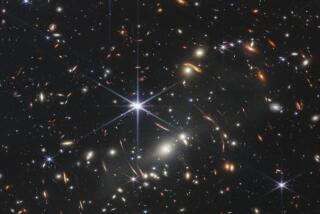Book Review : Science Wonders: What’s the Matter?
- Share via
The Dark Side of the Universe: A Scientist Explores the Mysteries of the Cosmos by James Trefil (Charles Scribner’s Sons: $17.95; 256 pages)
James Trefil is a physicist at the University of Virginia and an accomplished science writer. Several of his previous books, including “Meditations at 10,000 Feet” and “A Scientist at the Seashore,” have combined his scientist’s understanding of nature with a humanist’s understanding of people and eye for telling detail.
In “The Dark Side of the Universe,” Trefil turns his attention to the latest work in cosmology, particularly the growing understanding that 90% of the stuff of the universe is invisible--so-called “dark matter.” Unfortunately, Trefil has either forgotten or abandoned the humanist side of his earlier works and has written a treatise that is all but devoid of life.
Don’t get me wrong. “The Dark Side of the Universe” is a perfectly serviceable book. Readers interested in the current state of affairs in cosmological theory will find it explained here.
Fundamental Questions
“If you want to know the answers to the most fundamental questions science can ask, you have to turn to cosmology,” Trefil writes. “Throughout history, cosmologists have taken it upon themselves to answer questions like ‘How did the universe begin?’ or ‘How is it built?’ or ‘What is its future?’ ”
The currently held picture of cosmology--the origin and structure of the universe--contains some basic mysteries that can only be explained by the existence of large amounts of dark matter, stuff that we cannot see or perceive in any way except by its gravitational effect on the visible matter that we can see.
“We don’t know what makes up 90% of the universe, but we do know that it’s not something we’ve ever seen before,” Trefil writes.
But this is a difficult subject, and the book demands undivided attention. What, after all, is this dark matter made of? Trefil does as well as he can to make these ideas accessible to general readers, but the spark of his other works is missing. In their absence, the book reads more like a watered-down textbook than a piece of popular writing.
Along the way, Trefil throws in some observations about the ways of science, and these are the best parts of the book.
The Big Bang
He discusses, for example, the current theory of the Big Bang, which is believed to have started the universe. This theory stems directly from the observation by Edwin Hubble in the 1920s that galaxies are receding from the Earth and that the farther away they are, the faster they are receding. We know that distant galaxies are moving away because light from them is shifted toward the red end of the spectrum, the so-called red shift.
Run the film backward. If everything is moving away now, there must have been a time when all matter was collapsed into a single point, from which it exploded into the present expanding universe.
But Trefil recalls “a bag lunch in a prestigious physics department when a prominent senior member of the faculty . . . said that he often thought of leaving a sealed envelope to be opened 50 years after his death. In the envelope would be predictions about the way certain scientific controversies would turn out. At the top of the list would be the prediction that the interpretation of the red shift as evidence for a universal expansion would turn out to be wrong.”
At several places in the book, Trefil wonders about how scientists adopt new ideas and discard old ones. This process is supposed to be based on evidence. When there is enough evidence, its conclusions are inescapable.
When One Is Persuaded
In the real world, though, as Trefil rightly notes, it is an open question when the evidence is enough. When does an argument become persuasive? When it feels right. But this is hardly a scientific judgment.
Trefil gives a rule of thumb for predicting when a new idea in science will win favor and when it won’t. If the audience at the reading of a paper is smiling, the ideas being put forward will be accepted. Otherwise, the scientist proposing them faces a rough time.
It’s too bad that these observations seem grafted onto the exposition rather than an integral part of it. Trefil would have written a better book if he had concentrated more on the scientists and less on the science.
More to Read
Sign up for our Book Club newsletter
Get the latest news, events and more from the Los Angeles Times Book Club, and help us get L.A. reading and talking.
You may occasionally receive promotional content from the Los Angeles Times.








